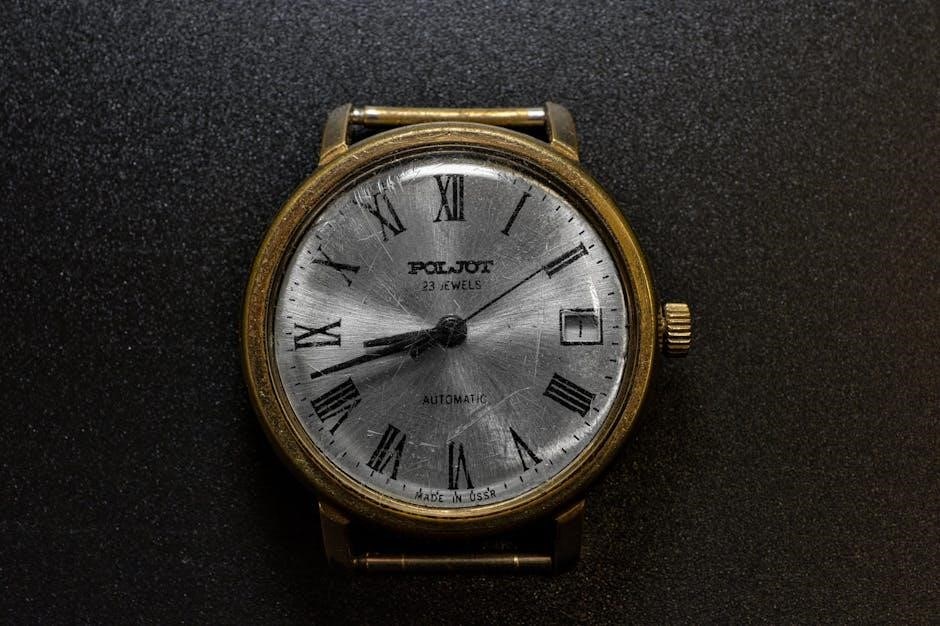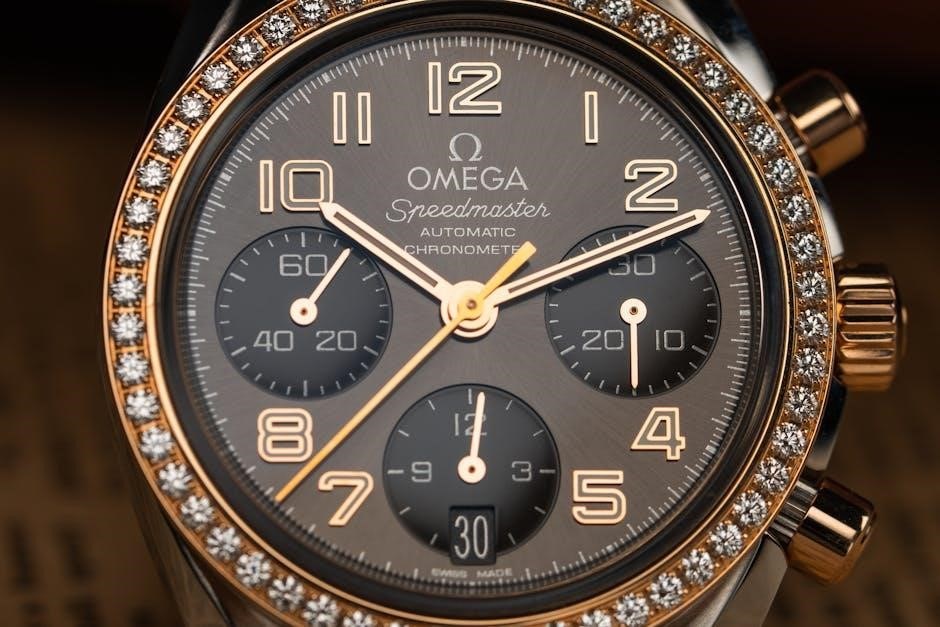Manual and automatic watches are two distinct types of timepieces, differing in their winding mechanisms. Manual watches require daily winding by hand, while automatic watches self-wind through wearer’s movements.
Definition and Basic Overview
A manual watch, also known as a hand-wound watch, requires the wearer to wind it daily by turning the crown. This mechanical process stores energy in the mainspring, powering the watch. Automatic watches, on the other hand, use a self-winding mechanism that harnesses the wearer’s movements to generate power, eliminating the need for daily winding. Both types rely on intricate mechanical movements but differ in how they are powered. Manual watches are often appreciated for their simplicity and craftsmanship, while automatic watches offer convenience and practicality for everyday use. Understanding these basics helps in choosing the right timepiece for personal preferences and lifestyle needs.
Historical Background

Manual watches trace their origins to the early days of watchmaking, with pocket watches emerging in the 16th century. These timepieces required daily winding, a routine that became synonymous with horology. The development of automatic watches began in the early 20th century, with Swiss watchmaker Abraham-Louis Perrelet pioneering the concept of a self-winding mechanism. Over time, automatic watches gained popularity for their convenience, while manual watches remained cherished for their craftsmanship and historical significance. Today, both types coexist, catering to different preferences and lifestyles. This historical evolution reflects the blend of tradition and innovation in watchmaking, shaping the diversity of modern timepieces.

Key Differences Between Manual and Automatic Watches
Manual watches require daily winding by hand, while automatic watches self-wind through the wearer’s movements, eliminating the need for manual intervention.
Movement Type
Manual watches feature a manual winding mechanism, where the wearer must turn the crown to wind the mainspring. This process is done daily to maintain power. Automatic watches, however, utilize a self-winding mechanism that harnesses the wearer’s movements to wind the mainspring continuously. This eliminates the need for daily winding, offering greater convenience. The movement type directly impacts the user experience, with manual watches appealing to those who enjoy the tactile ritual of winding, while automatic watches suit active individuals seeking a low-maintenance timepiece. Both mechanisms ensure precise timekeeping, though their operational differences cater to distinct preferences and lifestyles.
Power Source
The power source is a key differentiator between manual and automatic watches. Manual watches rely on a mainspring that is wound by hand, storing energy for a limited period. In contrast, automatic watches use a rotor that converts kinetic energy from the wearer’s movements into stored power, eliminating the need for manual winding. This difference in power sourcing affects convenience and maintenance, with manual watches requiring daily attention and automatic watches offering a more hands-off experience. The choice between the two often comes down to lifestyle and personal preference, as both mechanisms provide reliable timekeeping but cater to different user needs and habits.
Maintenance Requirements
Manual and automatic watches have distinct maintenance needs due to their mechanisms. Manual watches require regular winding, typically daily, to maintain accuracy and power reserve. They also need more frequent servicing because the manual winding mechanism is more prone to wear and tear. Automatic watches, while self-winding, still require periodic maintenance, usually every 3-5 years, to ensure the rotor and gears remain lubricated and functional. Both types benefit from routine cleaning and lubrication to maintain precision and extend lifespan. Proper care ensures optimal performance, making regular servicing a crucial part of owning either type of watch.
Exploring the pros and cons of manual and automatic watches helps users make informed decisions based on their lifestyle, budget, and personal preferences regarding timepieces. Manual watches offer a unique appeal for watch enthusiasts. They provide a tactile experience through daily winding, fostering a connection to the timepiece. These watches are often lighter and slimmer due to their simpler mechanics, making them more comfortable for everyday wear. Additionally, manual watches typically have a longer power reserve when fully wound, ensuring reliable timekeeping. They also tend to be more affordable than automatic watches, offering excellent value for those who appreciate craftsmanship without the higher cost. Overall, manual watches are a great choice for those who enjoy traditional watchmaking and the ritual of winding their timepiece. Manual watches have several drawbacks that may make them less convenient for some users. They require daily winding, which can be time-consuming and tedious. Forgetting to wind the watch can cause it to stop, leading to inaccurate timekeeping. Additionally, manual watches are more prone to damage if overwound, as this can strain the internal mechanisms. They also lack the convenience of automatic watches, which self-wind with movement. Furthermore, manual watches may not be suitable for individuals who prefer a low-maintenance timepiece. Overall, while manual watches offer a unique charm, their need for constant attention can be a significant downside for many wearers. Automatic watches offer several advantages that make them a popular choice among watch enthusiasts. Their self-winding mechanism eliminates the need for daily manual winding, providing unparalleled convenience. This feature is especially beneficial for individuals who value a low-maintenance timepiece. Automatic watches are also more prone to consistent timekeeping, as they are less likely to stop due to human error. Additionally, they often come with a longer power reserve, ensuring they remain accurate even when not worn for extended periods. The sleek design and engineering behind automatic watches also appeal to those who appreciate craftsmanship and innovation. Overall, automatic watches combine practicality with elegance, making them a versatile option for everyday wear. Automatic watches have certain drawbacks that may make them less ideal for some users. They often require more maintenance than manual watches, as their complex self-winding mechanisms can be prone to wear and tear over time. Additionally, automatic watches are typically thicker and heavier due to the rotor mechanism, which may not appeal to those who prefer slim, lightweight timepieces. They can also be more expensive, especially high-quality models with advanced features. Furthermore, automatic watches rely on the wearer’s movements to stay powered, meaning they may stop if not worn for an extended period. This dependence on motion can be inconvenient for individuals who do not wear their watch daily. Proper maintenance ensures longevity and accuracy of both manual and automatic watches. Regular servicing, water-resistance checks, and movement cleaning are essential for optimal performance and reliability over time. Winding a manual watch requires gentle, deliberate movements to avoid over-tightening the spring. Hold the watch firmly, grasp the crown, and turn it clockwise. Listen for clicking sounds to ensure smooth winding. Wind the watch fully each day to maintain consistent power reserve. Avoid over-winding, as it can strain the mechanism. Use a watch winder if you prefer convenience, setting it to 300-400 turns daily. Keep the watch away from extreme temperatures and magnetic fields to preserve accuracy. Regular maintenance, including cleaning and lubricating the movement, is crucial for longevity. Always store the watch in a cool, dry place when not in use. Automatic watches feature a self-winding mechanism powered by the wearer’s movements. Inside the watch, a rotor oscillates with each arm movement, transferring energy to the mainspring. This eliminates the need for daily winding. The rotor’s motion is captured by a gear train, which tightens the spring. Over-winding is prevented by a mechanism that disengages when the spring is fully charged. Optimal performance requires regular wear; if unused, the watch may stop within 40-70 hours. Maintenance is essential to ensure the rotor and gears function smoothly. Automatic watches are ideal for active users, offering convenience and reliability. Proper care extends their lifespan and accuracy. Manual watches are often more affordable than automatics due to simpler mechanics. Automatic watches, with self-winding technology, tend to be pricier but offer greater convenience. Manual watches typically start at lower price points, with entry-level models available from around $200 to $500. Mid-range options can range between $500 and $2,000, while luxury manual watches may exceed $5,000. Automatic watches, due to their complex self-winding mechanisms, generally start at a higher price, often between $500 and $1,500 for entry-level models. Mid-range automatic watches can range from $1,500 to $5,000, and luxury automatic timepieces can cost upwards of $10,000, depending on brand, materials, and features. This price difference reflects the added engineering and functionality of automatic movements compared to manual ones. Both manual and automatic watches can serve as solid investments, but their value retention varies. Luxury manual watches, often crafted with intricate details, tend to appreciate over time, especially if they are limited editions or from esteemed brands. Automatic watches, particularly those with unique complications or historical significance, also hold strong investment potential. However, more affordable automatic watches may not retain value as effectively as high-end manual timepieces. The brand, craftsmanship, and rarity play significant roles in determining long-term value. Collectors often favor manual watches for their exclusivity, while automatic watches with innovative mechanisms also attract investors seeking appreciating assets. Proper maintenance and provenance are crucial for maximizing resale value. Choosing between manual and automatic watches depends on lifestyle and personal taste. Manual watches appeal to enthusiasts who enjoy the ritual of winding, while automatic watches suit active individuals seeking convenience and reliability. Several factors influence the choice between manual and automatic watches. Lifestyle plays a significant role, as active individuals may prefer automatic watches for their convenience and self-winding capability. Manual watches, on the other hand, appeal to those who appreciate the tactile experience of winding their timepiece daily. Personal preference also matters, with some valuing the craftsmanship and heritage associated with manual watches, while others prioritize the practicality of automatic models. Additionally, the frequency of use and the need for maintenance can sway the decision. Budget considerations and brand loyalty further shape the choice, making it a multi-faceted decision. Practicality for daily use is a key consideration when choosing between manual and automatic watches. Automatic watches are generally more convenient, as they eliminate the need for daily winding, making them ideal for everyday wear. They are also more reliable in maintaining consistent timekeeping without interruption. Manual watches, while less practical, offer a unique connection to horological tradition. For individuals with busy lifestyles, automatic watches are preferable due to their low-maintenance design. Conversely, manual watches may appeal to those who enjoy the ritual of winding and appreciate the craftsmanship involved. Ultimately, the choice depends on balancing convenience and personal preference.
Advantages and Disadvantages
Pros of Manual Watches
Cons of Manual Watches
Pros of Automatic Watches
Cons of Automatic Watches

Maintenance and Care
Winding Techniques for Manual Watches
Self-Winding Mechanism in Automatic Watches
Cost Considerations
Price Range Comparison
Value Retention and Investment Potential
Lifestyle and Personal Preference
Factors Influencing the Choice
Practicality for Daily Use


